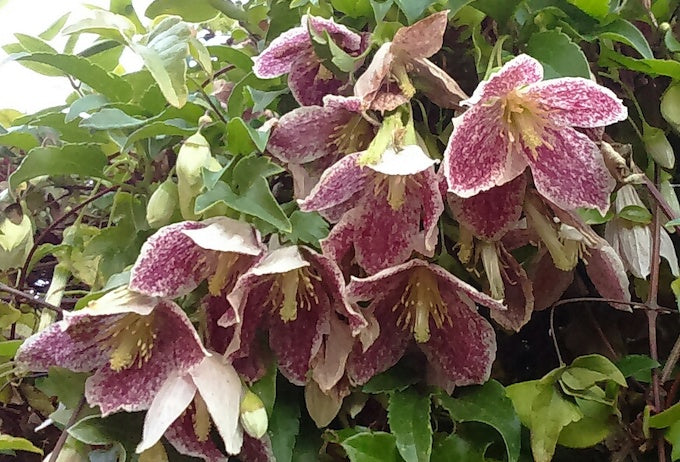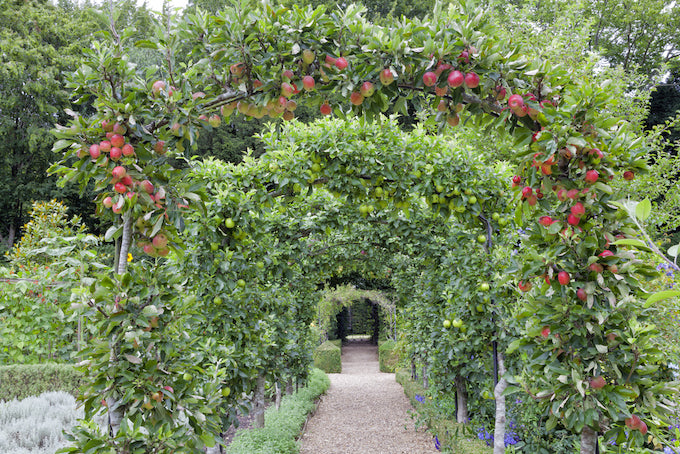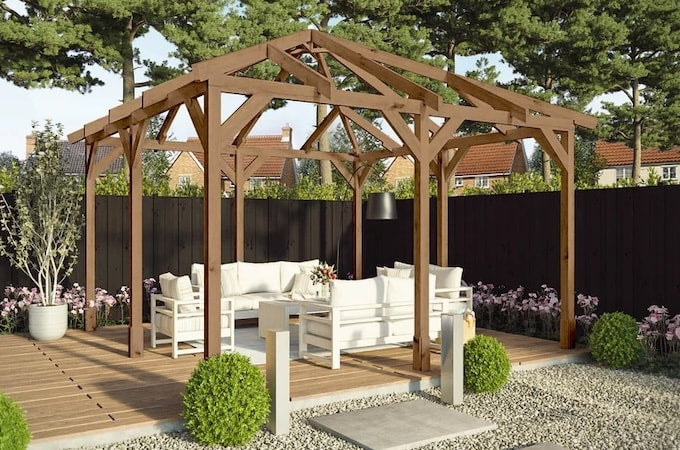It’s easy to concentrate on beds and borders when you’re planting your garden, but making use of vertical space is a great way to add drama. Here, garden designer Nic Wilson of dogwooddays shares some top tips for using climbing plants and wooden garden structures like pergolas and gazebos, arbour seats and arches and trellis panels to bring the focus up to eye-level.
Not sure what climbing plants to choose? Here are Nic’s favourite plants to give you all year round interest...
Climbing plants for spring beauty

Image source: Shuang Li/Shutterstock
Spring is often about looking down as snowdrops, daffodils and crocus burst up through the ground to herald the arrival of warmer weather. But spring flowering climbers can bring real beauty to your outside space. Raise your sights with some of these spring stunners:
The Chocolate Vine (Akebia quinata) has delicate brown-purple or cream flowers that spill from the semi-evergreen foliage with a delicious cocoa scent from March to May. Its tolerance of all soils and ability to cope with semi-shade as well as full sun makes the chocolate vine a versatile choice for any garden.
Wisteria is a cottage garden favourite and its lavender, violet, pink or white flowers bring an elegant beauty to the spring garden. Both Wisteria floribunda ‘Royal Purple’ and ‘Alba’ have achieved the RHS Award of Garden Merit for their excellent performance in ordinary garden situations. They’re vigorous climbers and need to be planted against a large, sturdy structure in a sunny position. Always buy a named variety grown from a cutting or grafted as these are much more likely to flower within 3 or 4 years.
Climbing plants for summer flowers

Image source: Nic Wilson of dogwooddays
Perennial climbers like clematis and honeysuckle (Lonicera) come into their own in the long summer months. Clematis flowers range from the dainty white bells of Clematis ‘Albiflora’ to the extravagant late summer blooms of Clematis ‘Jackmanii’, while delicate tubular Lonicera japonica flowers fill the air with fragrance. Clematis ‘Andromeda’ has dramatic semi-double flowers and prefers a shady spot, whereas Clematis ‘Rebecca’ produces its most vibrant flowers in full sun and is equally happy planted in the ground or in a container.
Summer annuals are perfect to add splashes of colour to trellis panels, posts and arches. Try growing Black-eyed Susan (Thunbergia alata) and Morning Glory (Ipomoea) from seed for flowers with big impact on a small budget. My favourite varieties include Thunbergia ‘African Sunset’ and Ipomoea ‘Dacapo Light Blue’.
Climbing plants for autumn colour

Image source: Nic Wilson of dogwooddays
Two of the best climbers for dramatic autumn foliage are the ornamental Vitis vinifera ‘Purpurea’ with its deep burgundy-purple leaves and Parthenocissus henryana – a less vigorous relative of Virginia Creeper but with similar fiery crimson foliage in autumn.
Cotoneaster horizontalis provides autumn and winter interest with sprays of vivid berries that attract birds like fieldfare and waxwing into the garden.
Pyracantha also has attractive berries and its branches provide nesting sites for birds during the breeding season.
Climbing plants for winter interest

Image source: Nic Wilson of dogwooddays
Don’t give up on colour over the colder months – plant Clematis ‘Freckles’ up an arch for a mass of purple-splotched bell flowers from autumn through to winter.
Alternatively, train Jasminum nudiflorum along a trellis or fence where its yellow star flowers will brighten up even the darkest corner.
Edible climbers

Image source: Yolanta/Shutterstock
Vertical growing isn’t restricted to ornamental plants – many edible crops can be grown against a fence or up an arch. Courgettes and squash can be grown this way. My favourite squash to grow over a sunny arch is the long, sweet and extremely prolific tromboncino.
Nasturtiums also thrive when trailing up supports, providing edible leaves, seeds and flowers throughout the summer.
For a more permanent display, train a fruit tree against a vertical support into a cordon, espalier or fan to provide architectural interest in winter, blossom in spring and fruits in autumn.
How to care for climbing plants

Image: 4m x 4m Pressure Treated Gazebo
Climbing plants bring an entirely new dimension to your garden, bringing height, structure, colour and even scent to your outside space. Here are my quick tips for successfully growing and caring for climbing plants:
- Plant climbers 30-45cm from the trellis, arch or pergola
- Water well throughout the first year
- Ensure that the correct supports are in place before planting
- Check whether you need to tie in the plant or whether it will cling to the support itself
- Tie stems in fairly loosely using biodegradable materials like string or twine
Nic Wilson is a writer, garden designer and Garden Media Guilds Awards nominee (Best Blog, 2018). She enjoys growing flowers and unusual fruit, vegetables and herbs, and loves to encourage nature into the garden. She also blogs at www.dogwooddays.net
Lead image: 4m x 4m Pressure Treated Pergola from Waltons




